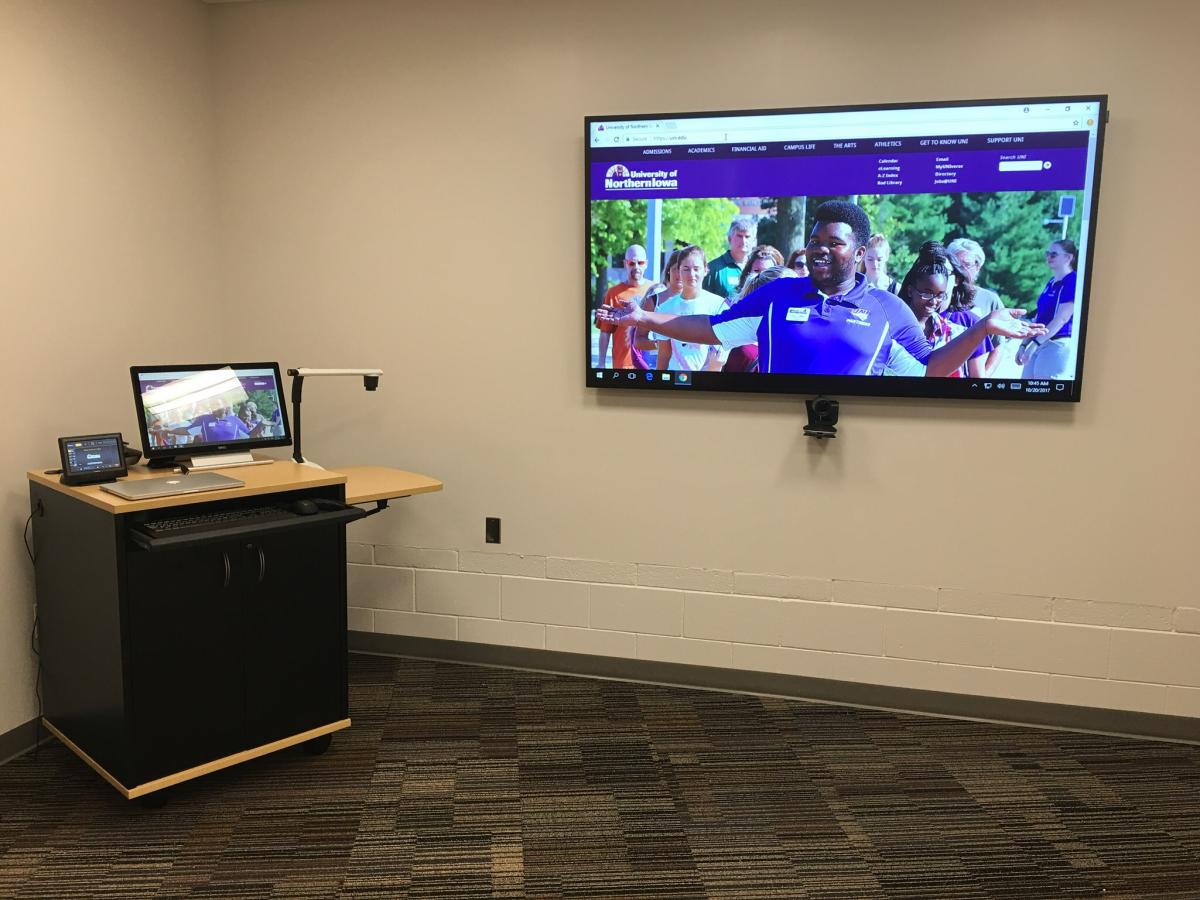Visitors Updates
Katie O’Brien teaches American Sign Language in the Communication Disorders program at UNI. During her classes, nobody talks, not even Katie! The only means of communication in the room are signing or writing. In order to provide content, she has learned how to use the SMARTBoard to its fullest capacity. She is able to have items prepared ahead of class for presentation with the flexibility to write on the screen as the class progresses or questions arise
.
In some classroom evaluation models, the level of noise in a room is used to measure the engagement of the students and the interactions with the instructor. In Katie’s room, the only sounds are from taps on the SMARTboard screen as things are displayed and manipulated by Katie. Despite the lack of noise, the student in the class remain very engaged through Katie’s teaching and the use of the technology.
Katie has been using the SMARTBoard for 14 years and would love to share her experiences with others who are interested in this technology.
In fact, she will be presenting a session on this use at the Technology-Enhanced Teaching and Learning conference on May 11th from 10:10-10:50 in her normal classroom CAC 116!
By Leigh Zeitz and Magda Galloway
Instructional Technology, Curriculum and Instruction, College of Education.
The 20th century idea of a computer lab involved rows of desks containing rows of computers with monitors on top. The computer teacher stood in the front of the room and the students peered around the monitors to see what computer teacher was sharing on her screen.
When Schindler Education Center was remodeled, we decided to rethink the essence of a computer lab. The concept of computing has changed. For the past decade, laptops have outsold desktops. A UNI survey found that 97% of our undergraduate students own laptops. What sense does it make to provide computers for students when they are more comfortable using their own?
So we created Room 133, a computer lab without desktop computers. Notice that we didn’t say “without computers” because we also have carts containing MacBooks, Chromebooks, and iPads . These computers are available for students who don’t have computers or their laptops are on the fritz. They are also quite useful when we want to engage our students in brand-specific software or we want to provide our students with the Chromebook or iPad experiences that they will probably have in their schools. Room 133 uses the baseline classroom configuration used across campus so teachers and students new to the environment can find familiar resources.
Room 133 includes non-computer resources as well. Our laptop cases store playful hands-on manipulatives (e.g., OSMOS; Dash and Dot Robots; and Bloxels.) It’s close proximity to the IRTS library in Schindler allows us to bring exciting enrichment tools like their Google Expedition cart to engage students in augmented-reality learning.
So what makes it a computer lab if it is not filled with computers? It is the infrastructure that supports computer-based learning. We have provided a flexible learning space. Our students have their choice of seating arrangements and choice of computer platforms. Integrating G Suite for Education into our curriculum provides us with a virtual collaborative space in the Google Cloud.
Technology’s place in the classroom fulfills the need for the right tools to support class projects. We structure the bulk of our assignments around collaboration, interactivity and striving towards using technology to redefine the learning process. Providing our students with the tools and opportunities to make decisions in their learning creates a student-centered learning environment. This process of modification or redefinition of the learning tasks is something that is advocated in Iowa’s schools using the SAMR model. We also integrate technology into the learning process using TPACK model where Technology finds a place to support Pedagogy and the Content Knowledge.
Another aspect of Room 133 is the mobile furniture that we have available. Desks and chairs are on wheels and various types of mobile furniture provide choice for our students. The advantage of our mobile furniture is that we can freely arrange the desks and seats as needed for teamwork. This flexibility is supported by the portable white boards and dry erase markers that are available for each student.
Room 133 is not a finished project. We like to consider it an ongoing enterprise where we are exploring new ways to provide unique learning opportunities for our future teachers. These experiences will expand their learning now and model possibilities that they can use with their students in the future.
It is great to see another classroom / learning space installed and ready to use at the University of Northern Iowa.
Our team has the opportunity in assisting the campus with the technologies installed in various spaces. We provide services with assessing the technology needs for the space, acquisition, installation, and training for the technology within these spaces.
Training involves both the “what buttons to push” to make the classroom operate to “best practices” on how to utilize the classrooms to have the most effective impact for engaged student learning.
This classroom has the capabilities to support wireless or wired screen sharing from mobile devices, document camera, DVD player as well as high definition local and international video and audio conferencing capabilities. It also has an easy to use control system.
The room looks a little empty as the furniture has not been delivered. This room will have a table in the center. Several other rooms we have completed have movable tables and chairs to allow for active learning capabilities.
If you're interested, http://classrooms.uni.edu is our web page that has an overview of technologies installed in our base standard classrooms.
Off to the next adventure!




